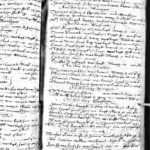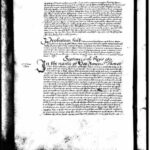
Date of Birth
About 1545
Place of Birth
Peterborough, Northamptonshire, England
Towns / Cities Moved Into
-
Known Occupation
-
Religion
-
Spouse
Death Information
Year of death
July 9, 1632
Place of death
Lilford, East Northamptonshire Borough, Northamptonshire, England
Cause of death
-
Burial location
St Peter's Church Lilford, East Northamptonshire Borough, Northamptonshire, England
Obituary

Parents

Edmund Elmes

Alice St. John
Marital Status


Married Christian Hickling
August 15, 1582
Greens Norton, Northamptonshire, England
Siblings



Children








Narrative / Story
Thomas Elmes’ life, spanning from about 1545 to 1632, was deeply rooted in the historical and socio-economic context of 16th and early 17th century England. Born in Peterborough, Northamptonshire, to Edmund Elmes and Alice St. John, Thomas grew up during a period of significant religious and social change. The introduction of the Book of Common Prayer in 1549 and the Act of Uniformity in 1558, which mandated church attendance, were indicative of the shifting religious landscape in England, transitioning towards Protestantism.
As the second son of his family, Thomas was not initially expected to inherit his father’s title. However, circumstances led to him becoming the designated heir, eventually becoming the Lord of the Manors of Lilford, Papley, and Warmington. This position likely shielded him from the socio-economic struggles faced by many during this era, such as the fines imposed by the Act of Uniformity, which would have been burdensome for the poorer populace.
In 1582, Thomas married Christian Hickling in Greens Norton, Northamptonshire. Together, they had a large family, including William, Mary, Edmund, Martha, Thomas, Anthony, John, and Frances Elmes. His life as a landowner and a family man would have been busy, overseeing his estates and ensuring the well-being of his family.
The socio-economic status of the Elmes family, as landowners, would have set them apart from many of their contemporaries who faced hardships due to economic fluctuations, such as those brought about by the introduction of the State Lottery in 1569. Their position likely insulated them from the direct impacts of such events, though they would have been aware of the broader societal changes.
Thomas’s life was also marked by the death of several of his children, a common occurrence in an era when child mortality rates were high. Despite his status, he would not have been immune to the personal tragedies that were a part of life during this time.
Upon his death in 1632 in Grene’s Norton, Northamptonshire, Thomas left behind a legacy as a significant figure in his community. His burial in St Peter’s Church in Lilford, where a monument commemorates him and his family, serves as a lasting testament to his life and status. His story, interwoven with the fabric of English history, offers a glimpse into the life of a 16th-century English nobleman, navigating the complexities of a changing world.

